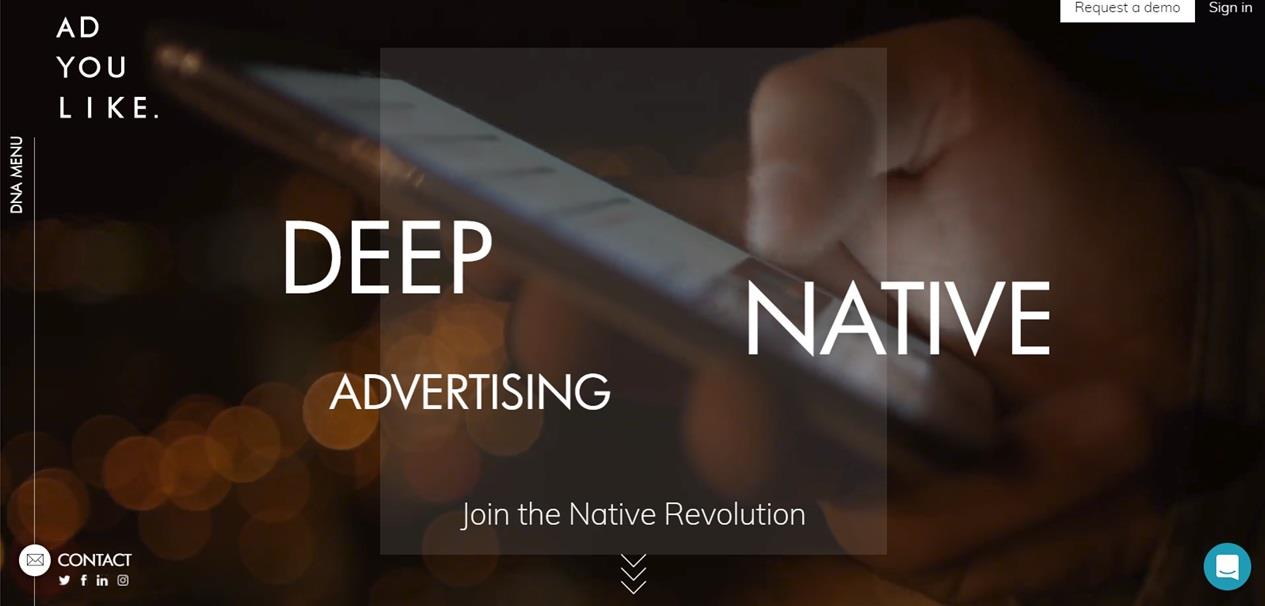The future of native advertising – Adyoulike UK MD Dale Lovell on media’s fastest growing ad format
One man who has witnessed the growth of the format at first hand is Dale Lovell, MD and CDO of ad platform Adyoulike.
 |
Photo: LinkedIn/dalelovell
Dale has just published a book on the growth of the format – Native Advertising: The Essential Guide and here gives his opinions as to where it has come from and where it will go in the future, discussing programmatic native, content studios and more along the way.
There will be many in depth discussions of native advertising at the 2018 DIS in Berlin in March. For ticket details, and a chance to save 600 Euros on the final price, click here.
You were something of a pioneer of native advertising? What sparked your interest and when was it? Why were you inspired to write the book?
All credit for my involvement in native advertising from the very early days should go to my business partner Francis Turner. He first made me aware of this new digital trend happening in the US market around content and digital distribution of content. Native advertising really was the term us, and many other digital entrepreneurs in the content space were looking for to best describe what we were doing around content. Like all new trends our interest started very organically; native advertising seemed the perfect fit to our individual skills, and our existing business at the time, Content Amp, which created and distributed branded content. We saw the native opportunity in the UK space and went all in on native advertising. That was five years or so ago – and I think we got that right. We merged our business with Adyoulike at the beginning of 2014 and took our awesome technical product and native ad offering to market. What inspired me to write the book was in part a desire to tell the story of native advertising as a whole over the last five years; how it has evolved and will continue to evolve – and also to offer a simple guide to what can, from the outside, look like a complex marketing channel full of buzzwords, acronyms and blurred lines. There’s no book out there that goes into as much detail about how native advertising fits into the modern digital advertising landscape.
How do you think native has developed in that time? How has it evolved? Is its success mainly due to ‘reader aversion to display advertising?’
Native advertising has changed since the early days, but not as much as some marketers would have you believe. The core of native advertising is simple: it’s advertising that is designed to look and feel like the editorial surrounding it. People often think of native advertising as BuzzFeed articles or branded content created by a publisher – but the term was first used to describe what social media channels like Facebook and Twitter were doing with their advertising formats. This is still true. Where native has evolved is really in the different types of native advertising that exist today. And our understanding of them all. For example, most marketers will know the branded content offerings of publisher studio teams such as The Telegraph, The Guardian, Trinity Mirror, Mashable and many more; most are also familiar with content recommendation as a product, as championed by the likes of Taboola and Outbrain. Equally, given the rise in mobile browsing, infeed native advertising, as championed by my business, Adyoulike, is frequently understood as a distinct, individual native distribution channel. Native advertising has evolved to contain many distinct product sets.
Is the success down to the aversion to display advertising? I don’t think consumers are averse to display ads. But the effectiveness of display advertising has fallen. And this has coincided with many media owners filling their digital assets with too many ads, which has killed consumer trust in these products as a result. Consumers expect to be engaged by advertising messages these days. Increasingly on mobile. Native advertising is in part an answer to this. Native advertising is the only ad format that really works on mobile. And mobile devices are where your customers congregate.
Do you think it will become an even bigger revenue resource for brands as time goes by?
I’m of the opinion that native advertising will be the main format digitally in the next five years. More and more money is flowing into programmatic native from traditional display and the transition for media buys to go programmatic continues apace, driven by agencies and advertisers. These are trends that are unlikely to change over the coming years.

Do you think that big media brands have finally realised the potential of the format?
I think more and more brands are recognising this format as key in driving their overall success. But there is more potential budget to be spent on the format. Areas such as programmatic native and native video formats are where the big, scalable opportunities exist in the coming years. The perfect cocktail of engaging format, content-led advertising, device and data targeting that native provides means that any brand that wants to reach an audience digitally – and I can think of very few that do not – needs to embrace native advertising as a format now.
Who do you think is producing good quality native advertising and why?
As I set out above there are now very distinct types of native advertising. The quality of the work is exceptional. Brands are on board with story-led ad messages, engaging formats and precise delivery. Many brands themselves are creating good, creative work. Publishers are creating truly creative work; brands such as The New York Times, The Telegraph, Quartz are always consistent, but the work brands such as The Ladbible, Unilad, Jungle Creations and The Hook Magazine do on far smaller budgets is always impressive, especially if you view the scale of distribution they achieve. But ‘good quality work’ isn’t just about the content, platforms such as ours consistently deliver great ROI for advertisers through connecting audience to advertiser, or as we like to say – putting content in context. This sort of technology really helps deliver great work that continually hits commercial highs for businesses.
What are the key issues that media brands need to think about when creating native?
Audience. Story. Messaging. Distribution. Think like a publisher; create content that adds value to your customer’s lives. Make it personable and don’t hammer home your sales messaging. Then think about distribution and reaching your target audience with non-intrusive, engaging formats, for the biggest chance of success.

What is Adyoulike’s role in native? And what exactly is ‘Deep native?’
Adyoulike pioneered native advertising in the European market. Adyoulike helped broaden market understanding of what native advertising is – with advertisers, publishers, agencies and wider media entities. As much as we capitalised on a trend, we also drove the market. I like to think we’ve helped influence and broaden the market’s understanding of native advertising.
Deep native is the phrase that we use to describe our AI led approach to native advertising. We use machine learning technology to create really deep connections between audience and content. As I said earlier, content in context. We do this via semantic technology we developed using IBM Watson. Watson was developed by IBM as an AI tool to take-part and win the US quiz show Jeopardy. It has the equivalent of 20M books in terms of accessible knowledge – and continues to grow. At Adyoulike we did a native first and integrated our network with Watson, building on this success to create deeper semantic targeting tools for brands and publishers.
Watson scans all the publisher pages in Adyoulike’s global network of premium publishers and analyses them in the same way as a human mind would: looking contextually for topics, sentiment and semantics rather than just scanning for simple keywords. Watson’s way of scanning allows the platform to deliver native content in-feed in the most relevant and targeted way possible. Watson looks at where, why and how the existing editorial content on each site is ‘talking about’ subjects and ensures advertisers are dynamically delivering the best native content to fit.
We are now able, in real time, to associate any kind of advertising content to the best matching editorial context, whatever the level of semantic targeting expected by advertisers and publishers.
Do you think that the creation of in house branded content divisions (Foundry, Guardian Labs etc) is a good way of solving the native question?
For many publisher brands content studios are potentially very profitable. The commercial content studio is still a relatively new phenomenon, however. Most studios are less than five years old in their current operations. Publishers have invested heavily and promoted extensively these entities as significant digital innovations.
But is there a downside? The downside to maintaining all of this content expertise is that it is expensive. Whether you are creating editorial content for consumers, or commercial content for a brand – the process of creating content that is actually good, that someone will find interesting, usually takes a lot of time. The problem with stuff that takes time is that it is difficult to scale.
Maintaining expensive in house staff – who are tasked with not just creating new and entertaining content, campaign to campaign, but are also juggling all the various sign-offs, re-works and approvals that content-led advertising goes through, is demanding. Plus, when you have major brands and agencies creating amazing multimedia brand content – the bar is set extremely high for the calibre of work an advertiser will expect to see from a publisher’s content studio in return. Expensive multi-media content and videography can quickly eat away at margin.
You need a lot of high paying work to maintain a high calibre creative team. Agencies have known this for years. Which is why most of them work on a retainer basis with their clients. This gives them a better ability to manage incoming revenue, which is key for planning stuff like how many staff you can afford to hire. This is extremely challenging to scale. Not all publishers will be able to do this. Those publishers that do so may increasingly come to resemble content agencies in terms of their make-up, attitude and financial model. Is that what they really want to become?
***Registration for DIS 2018 (19-20 March in Berlin) is now available. Save hundreds of euros on the registration price when you sign up before 1 December 2017. Secure your place here***
***Have a story to tell? Contact Cobus Heyl at cobus@fipp.com with speaker proposals for 2018. Include a brief description of the topic, why it is innovative and relative to our audience of top media people, and the name and brief biography of the proposed speaker. Media such as videos of previous presentations are also welcome***
More like this
How Bild works with native advertising
Why Snapchat should play a bigger role in your native advertising strategy
Washington Post’s important insights on selling native advertising
Native advertising to account for up to 40% of ad budgets by 2020
Download Native Advertising Trends 2017: The Magazine Media Industry
Ten top tips for native advertising success from Native Advertising Days 2017


![[New!] FIPP Global AI in Media Tracker – November 2025](https://www.fipp.com/wp-content/uploads/2025/06/articles-header-800x760.png)





